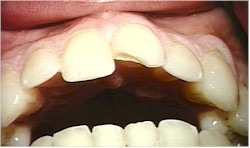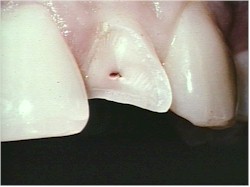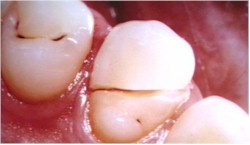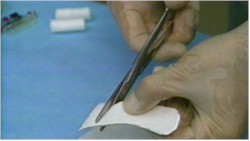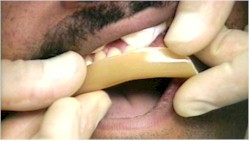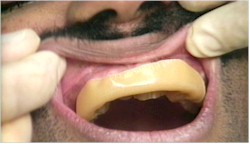|
|
|||||
Chipped Teeth
When a patient presents with a chipped or fractured tooth, the first step is to determine the extent of the damage. A patient with a minor or incomplete fracture will present complaining of tooth pain on chewing or sensitivity to cold. Minor fractures are relatively easy to treat, but the proper diagnosis must be made and other possible causes for tooth pain ruled out, including a fractured or lost restoration ("filling") and pulpitis (reversible and irreversible). The tooth may have a crack without the loss of tooth structure and still be basically intact, like a greenstick fracture. Using a penlight (transillumination), check for a crack in the tooth. See if the fracture extends below the tissue
Major Fractures Like a minor fracture, the goal in treatment is to alleviate the pain by preventing stimulation of the dentin. If the pulp has been exposed, you must NOT use IRM (Intermediate Restorative Material) or any other substance with eugenol to seal the tooth. The eugenol will kill the pulp. Seal a pulp-exposure with Dycal or another calcium hydroxide product first, then apply IRM. If only the dentin has been exposed, seal the fracture with IRM made of zinc oxide and eugenol. Stomahesive Application From "Dental Emergencies" Volume 803673 DN For additional information, read: "Dental Emergencies" in the General Medical Officer Manual. "Oral Diseases and Injuries" in the Hospital Corpsman 1 and C Manual.
Home · Military Medicine · Sick Call · Basic Exams · Medical Procedures · Lab and X-ray · The Pharmacy · The Library · Equipment · Patient Transport · Medical Force Protection · Operational Safety · Operational Settings · Special Operations · Humanitarian Missions · Instructions/Orders · Other Agencies · Video Gallery · Forms · Web Links · Acknowledgements · Help · Feedback Approved for public release; Distribution is unlimited.
*This web version is provided by The Brookside Associates, LLC. It contains original contents from the official US Navy NAVMED P-5139, but has been reformatted for web access and includes advertising and links that were not present in the original version. The medical information presented was reviewed and felt to be accurate in 2001. Medical knowledge and practice methods may have changed since that time. Some links may no longer be active. This web version has not been approved by the Department of the Navy or the Department of Defense. The presence of any advertising on these pages does not constitute an endorsement of that product or service by either the US Department of Defense or the Brookside Associates. The Brookside Associates is a private organization, not affiliated with the United States Department of Defense.
© 2015, Brookside Associates, LLC. All rights reserved |
|
||||

